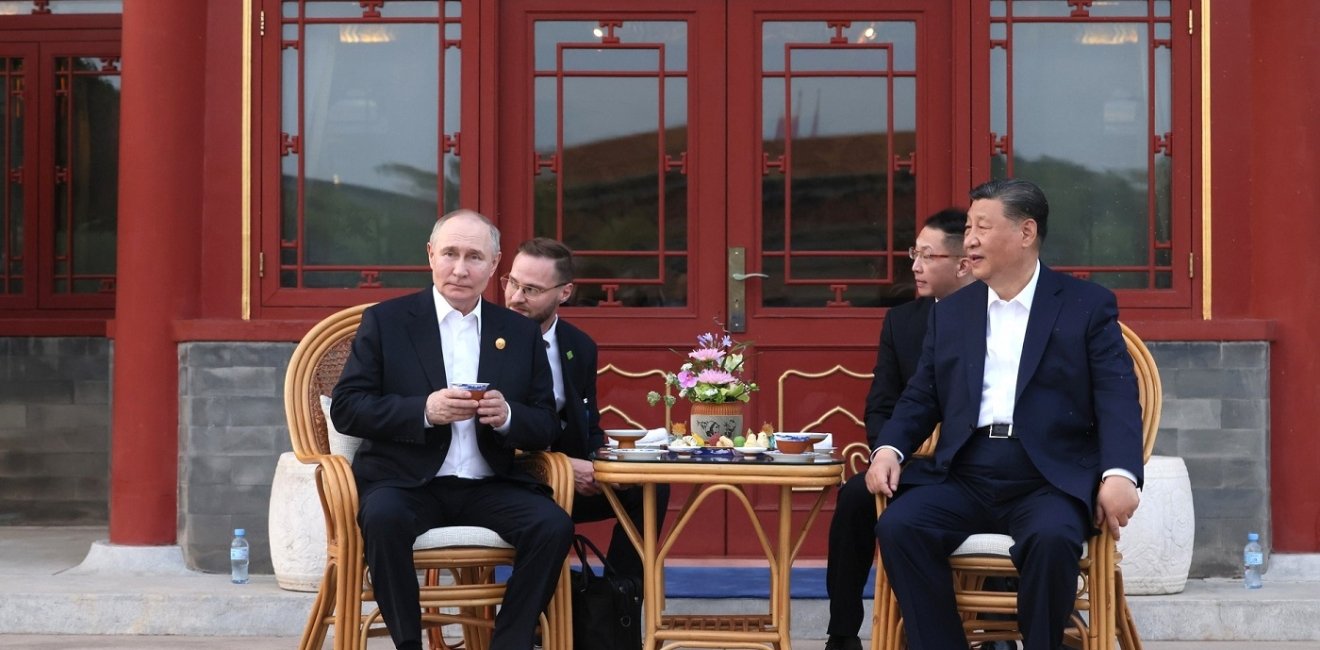
A blog of the Kennan Institute
Vladimir Putin’s state visit to Xi Jinping last week was meant to showcase the growing bond between Russia and China. However, behind the pomp and ceremony lies the reality of Russia’s increasing dependence on Chinese imports. Meanwhile, China is carefully balancing its policies to avoid excessively upsetting the United States and becoming too dependent on Russia.
The United States’ efforts to limit China’s shipments of dual-use goods to Russia seem to be having an impact. Russia is finding it harder to obtain the semiconductors and machine tools needed to sustain its war effort. Additionally, Putin’s plan to boost his failing gas revenues by building a second pipeline to China remains stalled.
Yet China is a winner in a situation created by Russia’s brutal war against Ukraine. China has expanded its market presence in Russia and secured affordable Russian hydrocarbons, but only to a degree that maintains its diversified portfolio of energy sources.
Aborted Trade Growth
Chinese-Russian trade has seen explosive growth since the launch of Russia’s full-scale invasion of Ukraine in February 2022. With bilateral trade surging from $145 billion in 2021 to $240 billion in 2023, China has solidified its position as Russia’s main trading partner.
The primary areas of cooperation include energy, agriculture, technology, infrastructure construction, and transportation, Putin pointed out during his visit to Beijing. What this really means is that China is Russia’s top source for the types of goods that the United States identifies as “high-priority” items. These goods—including semiconductors, telecommunications equipment, and machine tools—can be used in both civilian and military sectors.
In December 2023, monthly exports of these dual-use products from China to Russia reached over $600 million but have since fallen to over $300 million per month. Despite this decrease, China’s support for Russia’s war effort through these supplies has been substantial. Russia’s dependence on China for these products has surged from 32 percent in 2021 to 89 percent in 2023.
The decrease in shipments to Russia shows that Beijing is managing its risks because of U.S. policies. During his April 2024 visit to China, U.S. Secretary of State Antony Blinken expressed concern about China being a top supplier to Russia’s defense sector. He warned that the United States might impose additional sanctions on Chinese banks and companies if China does not address this issue.
By then, China had already started reducing its exports to Russia. Major Chinese banks were already refusing to serve Russian clients who may be linked to the military-industrial complex. According to China’s general administration of customs, in March, China’s exports to Russia fell by 16 percent, marking the first drop since mid-2022, with significant declines in shipments of machinery and equipment. In April, year-over-year shipments in dollar terms were down again, by 13 percent, to $8.3 billion.
For the past few months, Russian entrepreneurs have been complaining that they experience problems when paying for any goods, not just those subject to Western sanctions. U.S. warnings did play a role. A banker at one of China’s Big Four state banks told Reuters his bank had tightened scrutiny of Russia-related businesses to avert sanctions risk. “The main reason is to avoid unnecessary troubles,” he said.
It is unclear, though, to what extent China’s decreased shipment numbers are genuine. “Transactions between China and Russia will increasingly go through underground channels,” the head of a trade body in a southeastern province that represents Chinese businesses with Russian interests told Reuters. Making payments in cryptocurrencies, banned in China since 2021, might be the only option, a Moscow-based Russian banker is quoted as saying. “It’s impossible to pass through KYC (know-your-customer) at Chinese banks, big or small,” the banker said.
Energy Relations and Energy Revenue
Energy remains a cornerstone of Sino-Russian economic relations and a check of the Russian government’s ability to defend its long-term economic interests. For years, Moscow has been pushing to expand its pipeline routes to China, an effort that became particularly topical after 2022 and 2023. By trying to exert pressure on European powers through his dominance of European gas markets, Putin persuaded them to diversify quickly and at all costs, which Europe did.
Norway and Algeria, which together supplied less gas than Gazprom alone until 2022, became the largest suppliers of pipeline gas to Europe in 2023. Gazprom lost its most important market, which took the Soviet Union and Russia decades to build and maintain. In 2023, Gazprom reported a loss of $7 billion, its first annual loss since 1999.
The Power of Siberia 1 gas pipeline, operational since 2019, is the transport route to China that Russia has sought for years to expand. Yet Xi Jinping has resisted Moscow’s efforts to secure a contract for Siberia 2. “Such a deepening of dependence on Russia would cut against China’s energy security strategy. China, which imports 42 per cent of its gas supply, has made efforts over the last two decades to diversify its energy imports to reduce its dependency on any one source,” writes Aiqun Yu, a senior East Asia strategist with Global Energy Monitor.
All that said, Russia’s overall oil and gas revenues remain strong and have even been showing remarkable growth lately. In the first quarter, oil and gas revenues to the Russian budget amounted to almost 3 trillion rubles (almost $33 billion), an astonishing 80 percent year-over-year jump. One source of this is the ruble devaluation by almost 25 percent. But the main factor is the growth of Russian oil prices because of the easing of a discount on Urals oil, Russia’s benchmark brand, to Brent.
China is pocketing most of the profits from Moscow’s increasingly dependent position vis-à-vis Beijing. Yet, on balance, Russia’s economic standing remains remarkably robust. The West has had mixed results in limiting Russia’s main source of revenue and China’s capacity to supply Moscow with dual-use goods. China, for its part, has managed to balance its relations with the United States and Russia. New thinking is needed to affect Russia’s willingness and ability to wage its war against Ukraine and the West.
The opinions expressed in this article are those solely of the author and do not reflect the views of the Kennan Institute.
Author

Editor-at-Large, Meduza

Kennan Institute
After more than 50 years as a vital part of the Wilson Center legacy, the Kennan Institute has become an independent think tank. You can find the current website for the Kennan Institute at kennaninstitute.org. Please look for future announcements about partnership activities between the Wilson Center and the Kennan Institute at Wilson Center Press Room. The Kennan Institute is the premier US center for advanced research on Eurasia and the oldest and largest regional program at the Woodrow Wilson International Center for Scholars. The Kennan Institute is committed to improving American understanding of Russia, Ukraine, Central Asia, the South Caucasus, and the surrounding region through research and exchange. Read more

Explore More in The Russia File
Browse The Russia File
Chechnya as a Model of Modern Russia

Russia’s Indigenous Communities and the War in Ukraine

Gas and Power in a Changing US–Russia Relationship

